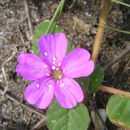Comments
provided by eFloras
A. L. Bogle (1974) indicated that the flowers of Okenia hypogaea may be cleistogamous. Information provided on a specimen label suggests that flowers with a conspicuous perianth are staminate and that cleistogamous flowers are rare. The reproductive biology is in need of study. Herbarium specimens very rarely contain fruits. Peduncles may be mistaken for adventitious roots by collectors, the fruit very easily torn from the peduncle as the plant is taken. The descending peduncle resembles a root to the point that a conic cap of cells, resembling a root cap, develops over the tip of the perianth base that is to become part of the fruit (A. L. Bogle 1974).
- license
- cc-by-nc-sa-3.0
- copyright
- Missouri Botanical Garden, 4344 Shaw Boulevard, St. Louis, MO, 63110 USA
Description
provided by eFloras
Stems 0.2-2 m. Leaves: small leaf of pair often not equaling petiole of larger leaf; petiole 8-45 mm; blade ovate, ovate-deltate, or elliptic-ovate, 9-50 × 3-45 mm, base slightly to strongly oblique, truncate to cordate, margins sinuate and undulate, apex usually rounded, sometimes obtuse or acute, surfaces often red-punctate. Inflorescences: peduncle 1-9 mm at anthesis, rapidly elongating and curving downward as perianth wilts, ultimately 10-30 cm. Perianth magenta [rarely yellow], 10-30[-50] × 9-30[-45] mm. Fruits brownish or whitish, 9-13 × 6-9 mm.
- license
- cc-by-nc-sa-3.0
- copyright
- Missouri Botanical Garden, 4344 Shaw Boulevard, St. Louis, MO, 63110 USA
Distribution
provided by eFloras
Fla.; Mexico; Central America (Nicaragua).
- license
- cc-by-nc-sa-3.0
- copyright
- Missouri Botanical Garden, 4344 Shaw Boulevard, St. Louis, MO, 63110 USA
Flowering/Fruiting
provided by eFloras
Flowering early spring-late fall [year-round].
- license
- cc-by-nc-sa-3.0
- copyright
- Missouri Botanical Garden, 4344 Shaw Boulevard, St. Louis, MO, 63110 USA
Habitat
provided by eFloras
Sandy areas along coast [inland]; 0[-1800]m.
- license
- cc-by-nc-sa-3.0
- copyright
- Missouri Botanical Garden, 4344 Shaw Boulevard, St. Louis, MO, 63110 USA
Comprehensive Description
provided by North American Flora
Okenia hypogaea Schlecht. & Cham. Linnaea 5: 92. 1830
Okenia grandi flora Standley, Contr. U. S. Nat. Herb. 13: 397. 1911. Okenia Rosei Standley, Contr. U. S. Nat. Herb. 13: 398. 1911.
Stems 1-20 dm. long, much branched, the branches slender, divaricate, densely viscidvillous; leaves of a pair very unequal, the smaller often shorter than the petiole of the larger one, the petioles 0.5-6 cm. long, often longer than the blades, the blades orbicular-rhombic to oval, oblong, or deltoidovate, 1.8-5.5 cm. long, 1-4.5 cm. wide, subcordate to broadly cuneate at the base, unequal, broadly rounded to acutish at the apex, entire or usually sinuate, yellowish-green, densely covered on both surfaces with minute sessile brown glands, viscidvillous; bracts linear-lanceolate, long-attenuate, 2-3 mm. long; pedicels in age often 20-30 cm. long, slender, villous; perianth purplish-red, 3-6 cm. long, densely viscidvillous outside, the limb 1-3.5 cm. broad; fruit 9-13 mm. long, 6-9 mm. in diameter, strongly rugose, brown, glabrous; seed 7 mm. long, dark -brown.
Type locality: Sandhills near Veracruz, Veracruz.
Distribution: Sandy coasts, Florida keys; Veracruz to Campeche; Sinaloa to Oaxaca; inland
- bibliographic citation
- Paul Carpenter Standley. 1918. (CHENOPODIALES); ALLIONIACEAE. North American flora. vol 21(3). New York Botanical Garden, New York, NY

